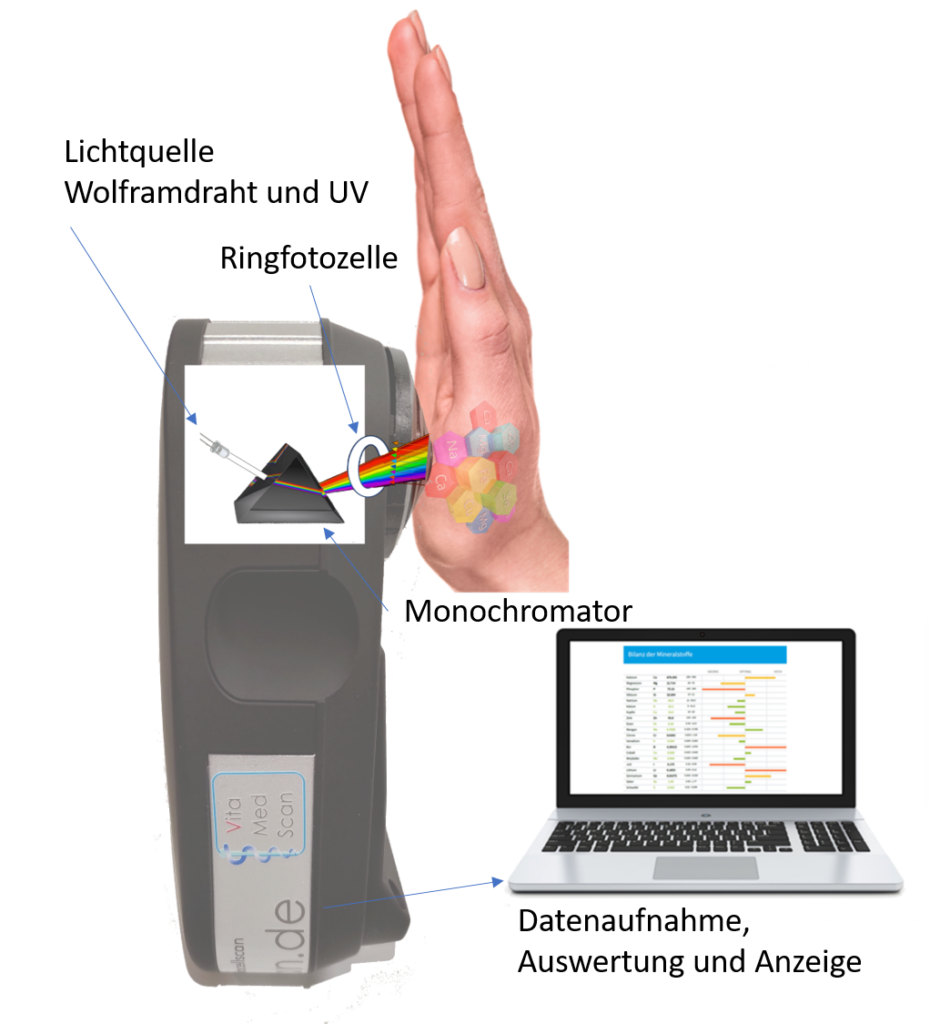
The VitaMedScan
With the use of the VitaMedScan, 20 trace elements, minerals and the 14 most important toxic metals can be detected intracellularly (predominantly) and extracellularly in the surrounding tissue. This is done by an optical method, the so-called spectrophotometry, in which a known chemical substance is measured by the concentrated light beam by measuring the degree of absorption and optical density.
The principle
A spectrometer or spectroscope is a device that makes it possible to carry out a spectrometric measurement of the absorption of a solution at a given wavelength or over a given range of the spectrum.
Spectrophotometry is the field in which the measurement of the energy transported by electromagnetic radiation in the range of visible light is investigated.
We have selected an X-Rite i1Pro2 device (VitaMedScan) as a measuring instrument, which is a spectrophotometer. This device therefore makes it possible to search for and quantify an appropriate pre-calibration, an ion (anion or cation) or a molecule. For this purpose, the device performs a first series of measurements at a point on the palm of the hand. The same process is repeated at two other points in the hand. All data is then sent by remote transmission to the headquarters of our company, where it is processed by software on a mainframe. This determines the average of the three specific measurements that are carried out at the therapist for each element sought and then calculates a quantitative average.
After that, the average value for each element is compared with the result of an “ideal” person. The amount that the therapist found during the patient’s analysis makes it possible to determine whether the value is in the deficiency, in the excess or in the ideal value.
After taking into account the various elements measured at the beginning, the software therefore first sends (always by remote transmission) the results for each element sought to the therapist. Depending on the shortcomings or surpluses of all analyzed elements, the software then selects foods and active ingredients (in dietary supplements) to bring the patient back into balance in order to get as close as possible to the set “ideal” values.

Function of the VitaMedScan
The device measures certain points in the tissue, in the epithelial cells, the palm. The results are presented in an understandable way with the help of a traffic light system. The traffic light system divides the measured values into three different ranges: normal range (green), sub-optimal range above or below the normal values (yellow) and deficiency or excess range (red). In this way, deviations can be detected very easily and appropriate measures can be initiated.
What can the Vita Cell Scan measure?
Which measurement results can be determined with the VitaMedScan:
- The most important 20 minerals and trace elements
- 14 toxic metals- The degree of toxic load is determined
- The ratio of certain minerals to each other
- Antioxidant capacity – Oxidative stress generally occurs when too many free radicals are formed and there are not enough antioxidants to break them down.
- Antioxidant capacity – Oxidative stress is responsible for ageing and for numerous disorders and diseases of the organism.
- The antioxidant capacity indicates the extent to which oxidised carotenoids can be neutralised. Zn, Cu, Se, Mn, Ge are analysed.
Enzymatic status The functional state of the intestine, especially the enzymatic balance, is determined. The results of Zn, Fe, Cu, Mn and Se are assessed in the algorithm.
Metabolism Metabolism is defined as the transport and chemical conversion of substances with the help of enzymes. Its function is assessed using an algorithm of results for Cr, Mo, J.
Immune system This index shows the level of the immune system to check whether all components important for its optimal function are present. These are Zn, Cu, Mg, Se and Ge.
Cognitive functions This is based on the algorithms of the substances Zn, Fe, J, P and Al, Bi, which are important for mental function.
Hormonal status Hormone function is determined by minerals and toxins such as heavy metals, among other things. The hormonal status is based on the algorithm of Zn, J, Hg and Pb.14
Cardiovascular system This index shows the condition of the cardiovascular system, i.e. whether all the substances necessary for its function are present. It is based on an algorithm that takes into account the results of Mg, Na, Ca, Se, Cr and Si.
Insulin resistance This index shows whether the patient has a predisposition to diabetes, whether all the substances necessary for the pancreas to function optimally are present. It is based on an algorithm that includes the results for Zn, Mg, P, Vn, Cr and Hg.
Small intestine assimilation, intestinal barrier . This index indicates the state of the intestinal barrier function and the absorption capacity of nutrients. If this is poor, not only is the absorption of nutrients impaired, but “toxins” and other “intruders” can also easily penetrate the intestinal wall. It is based on an algorithm that takes into account the results for Zn, Fe, Mn, Cu, and Cr.
Allergy status This index describes the possibility of suffering from allergies. The results of the algorithms for Zn, Cu, Mg, P, Se and Ge are included here.
Nervous system This index describes the state of nerve function, but also the patient’s resistance to stress and mental relaxation, provided that all substances for optimal functioning are present. It is based on an algorithm that includes the results of Mg, Ca, Na, K, Co.
Acid-base balance This index describes the ratio of acids and bases in the body, with alkaline minerals playing a particularly important role. The results of P, Mg, Ca, Si and Zn are included in the algorithm.
Regeneration of connective This index shows the patient’s healing capacity, but also his “anti-wrinkle” capacity, when all the necessary components for good functioning are present. It is based on an algorithm that takes into account the results of Zn and Si.15
Emotional status This index shows the patient’s emotional function, but also their ability to control themselves and their anti-stress capacity, provided that all the components for an optimal response are present. Zn, J, Hg and Pb are included here.
The measured results support the doctor/therapist in recognising the causes of disorders, in being able to initiate further clarifications if necessary and in being able to provide causal therapeutic support.
All metabolic reactions are dependent on physical conditions.
The degree of acidosis of the tissue, the ratio of the most important mineral polarities, the antioxidant capacity and the condition of the cell membranes play an important role here.
Due to the fact that the VitaMedScan measures mainly intracellularly in the palm area, many therapy-relevant findings can be obtained, which is precisely what makes this measurement method so revolutionary, as shifts in the mineral intracellular concentrations can prevent incorrect therapeutic decisions.
In some patients, for example, it was found that although the whole blood analysis showed a zinc deficiency, the intracellular concentration of zinc had increased massively.
This zinc and copper phenomenon is often also found with iron.
Patients with chronic inflammation (or cancer) mobilise iron, zinc and copper from the blood towards the cells (particularly noticeable in the liver and other metabolically highly active organs). In the determination of iron (ferritin/haemoglobin) or in serum/whole blood analysis, the concentrations in the blood fall, while the concentration in the cells increases. This is mainly due to the fact that the enzyme superoxide dismutase is “upregulated”, which, among other things, draws in zinc and copper.
Determinable measurement results
With the VitaMedScan, the following results can be determined:
- The 20 most important minerals and trace elements in the human body
- The ratio of minerals to each other (ratios)
- 14 toxic metals
- The degree of toxic metal contamination
- Antioxidant capacity
- Interrelations
- Active ingredient recommendations
- Nutritional assessment
In addition:
- immediate graphic representation of the composition of vital substances
- Make exposure to toxic metals visible
- Photospectral analysis is a proven diagnostic procedure in the laboratory field
- precise and reproducible
- delegable
- Billing option according to GoÄ, GebüH, GoÄ, GOZ, LNZ, E-Pos.
- high patient acceptance
- individual therapy

Minerals are essential for the human body, i.e. it cannot produce them itself. So he has to take them from the outside. This is becoming increasingly difficult for him, as the quality of the food or Food is getting worse and worse. The foods contain fewer and fewer vital substances and thus fewer minerals.
A total of 46 are present in the organism – of which 20 are recorded in the VitaMedScan. The minerals can be divided into two groups due to the quantitative distribution in the body: the “actual minerals” and the trace elements”, which are also chemically minerals.
Minerals are among the micronutrients, as they are chemically used as individual substances or Elements occur and are divided into different groups in the periodic table of the elements.

Some conclusions can be drawn from the ratios/ratios between two minerals, e.g. B.:
– Ca/Mg high: Parathyroid dominance and hyperinsulinism.
– Ca/P: Protein metabolism. If high then anabolism with parasympathetic dominance.
– K/Na low: Stress reaction and chronic inflammation.

In the effects and burdens of toxic heavy metals, a distinction is made between acute and chronic effects. The acute effects usually occur with direct contact and often also with small amounts, such as arsenin. Chronic effects can be seen in a variety of problems and clinical symptoms. These include mutagenic and carcinogenic effects, neurotoxic effects, effects on the skeletal system, kidney function, the immune system, blood formation and interactions with essential elements.
Heavy metals and toxic exposures are seen in complementary medicine as important factors of a wide variety of chronic diseases.

Antioxidant capacity
This note measures the oxidized caratinoids. It indicates the real state of health of the organism.



Acid-base balance
This index shows that the patient is in a phase of hyper-acidity.
Insulin resistance
This index shows whether the patient has a diabetes predisposition, whether all the necessary substances for the optimal functioning of the pancreas are present.
Allergy status
This index shows whether the patient has a predisposition to allergies.
Enzymatic status
This index, similar to that of the “function intestinal barrier”, shows the functional state of the intestine, especially its enzymatic balance.
Assimilation of the small intestine
This index, similar to the enzyme status, also shows the state of the intestine, in particular the degree of barrier function.
Metabolism
This index allows you to see the degree of metabolism, it is based on an algorithm that takes into account the results for Cr, Mo and J.
Immune system
This index shows the level of the immune system to detect whether all important components are present for its optimal function.
Cognitive function
This index shows the mental function of whether all the necessary components are present for their optimal functioning.
Hormonal status
This index shows the hormonal function, whether all components important for their optimal function are present.
Regeneration of connective tissue
This index shows the state of the patient’s healing ability, but also his “anti-wrinkle” capacity, when all the necessary components for good functioning are present.
Emotional status
This index shows the emotional function, but also the possibility of self-control and anti-stress of the patient.
Cardiovascular system
This index shows the state of the cardiovascular system, i.e. whether all the substances necessary for its function are present.
Nervous system
This index shows the state of nerve function, but also the resistance to stress and mental relaxation of the patient.
Limits of the spectrometer
A vitamin measurement is not possible.
A blood glucose measurement is not possible.
Blood pressure cannot be measured.

Detection of 20 minerals and trace elements.
Measurement of 14 toxic metals.
Determination of antioxidant capacity.

